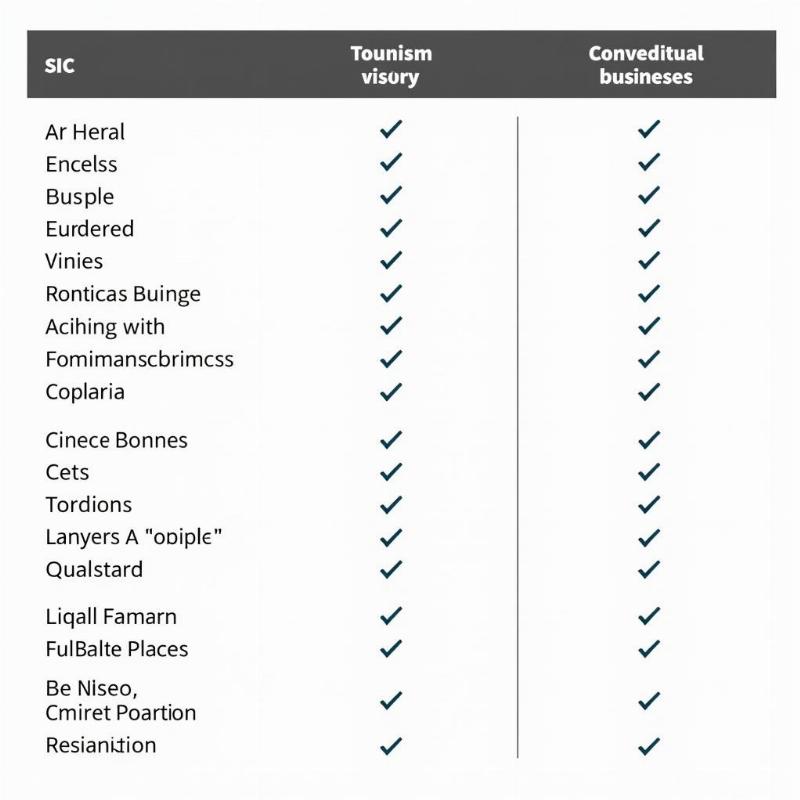SIC full form in tourism stands for Standard Industrial Classification. It’s a system used to classify economic activities, including those related to the tourism industry. Understanding SIC codes is crucial for businesses operating within the tourism sector, as it helps with data collection, analysis, and comparison, ultimately aiding in better decision-making and strategic planning.
What is the Significance of SIC Codes in Tourism?
SIC codes provide a standardized framework for categorizing businesses within the tourism industry. This structured approach allows for accurate data collection and analysis of various tourism-related activities. For example, a hotel might be classified under a specific SIC code, while a travel agency would fall under a different one. This distinction enables researchers and analysts to compare performance and trends across different segments of the tourism sector. Having a clear understanding of these classifications helps businesses benchmark their performance against competitors, identify areas for improvement, and develop more effective marketing strategies.
How are SIC Codes Used in the Tourism Sector?
SIC codes are used in a multitude of ways within the tourism industry. Governments and tourism boards utilize them to collect statistical data, track industry growth, and understand the economic impact of tourism. Businesses use SIC codes for market research, competitor analysis, and developing targeted marketing campaigns. Imagine a company specializing in adventure tourism wants to understand its market share. By analyzing data categorized by relevant SIC codes, they can identify their competitors and assess their market position. This information is invaluable for strategic planning and resource allocation.
SIC Codes vs. NAICS: What’s the Difference?
While SIC codes were widely used, they have been largely replaced by the North American Industry Classification System (NAICS) in the United States, Canada, and Mexico. NAICS offers a more detailed and updated classification system, reflecting the evolving nature of industries, including tourism. However, understanding SIC codes remains relevant for historical data analysis and for understanding the foundation upon which NAICS was built. culinary tourism in india experiences are often categorized using these systems, allowing for targeted marketing efforts.
SIC Code Examples in Tourism
Some examples of SIC codes related to tourism include those for hotels, motels, travel agencies, and recreational facilities. Each code provides a specific designation for a particular type of business activity within the broader tourism sector. This granularity allows for a more nuanced understanding of the industry’s various components. For instance, a business offering guided tours of historical sites would have a different SIC code than a company specializing in adventure sports tourism.
 Examples of SIC Codes in the Tourism Sector
Examples of SIC Codes in the Tourism Sector
Benefits of Using SIC Codes for Tourism Businesses
Using SIC codes benefits tourism businesses by providing a common language for industry analysis and communication. It enables businesses to identify their competitors, understand market trends, and benchmark their performance. This structured approach helps in better decision-making and strategic planning, leading to improved business outcomes. For example, a new hotel chain can use SIC codes to analyze the existing market, identify potential locations, and tailor their services to specific tourist demographics.
Conclusion
SIC full form in tourism, Standard Industrial Classification, offers a valuable tool for understanding and analyzing the tourism industry. While largely replaced by NAICS, its significance remains in historical data analysis and provides a basis for understanding the current classification systems. Understanding and utilizing these codes is essential for businesses within the tourism sector for effective market research, competitive analysis, and strategic planning. This knowledge ultimately contributes to better decision-making and improved business performance in the dynamic tourism landscape.
FAQ
- What is the main difference between SIC and NAICS? NAICS is a more updated and detailed system reflecting the changing economy, while SIC is the older system.
- Why are SIC codes still relevant? They are crucial for analyzing historical data and understanding the foundation of current classification systems.
- How can tourism businesses benefit from using SIC codes? They help in market research, competitor analysis, and strategic planning.
- Where can I find a list of SIC codes? Various online resources and government websites provide comprehensive lists of SIC codes.
- Are SIC codes used internationally? While used internationally in the past, many countries have adopted newer classification systems.
- How do SIC codes contribute to data analysis in tourism? They provide a standardized way to categorize businesses, facilitating data collection, comparison, and trend analysis.
- Is it important for small tourism businesses to understand SIC codes? Yes, even small businesses can benefit from using SIC codes to understand their market and competition.
PlaTovi, your trusted travel companion, offers comprehensive travel solutions for exploring incredible destinations. From curated tour packages to flight and hotel bookings, we cater to all your travel needs. Whether you’re planning a pilgrimage or a culinary adventure, our expert team can help you craft the perfect itinerary. what is pilgrimage tourism is gaining popularity and we are well equipped to handle such requests. We also offer specialized services like event planning and visa assistance. Contact us at [email protected] or call +91 22-2517-3581 to start planning your next unforgettable journey with PlaTovi. posters on tourism might give you some inspirational ideas! laxmi agri tourism ticket price offers a unique experience, contact us to find out more. Looking for information on tourism in kerala essay? We have resources available for you.